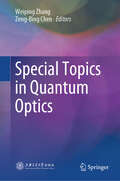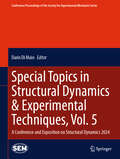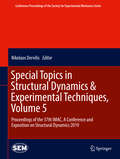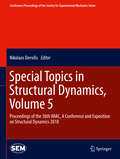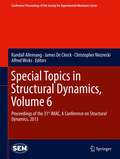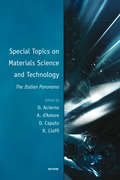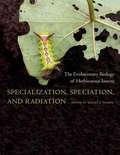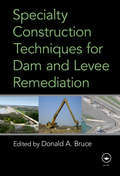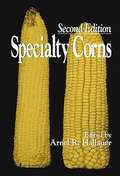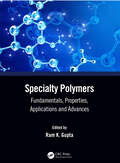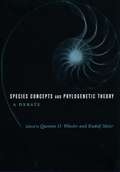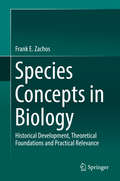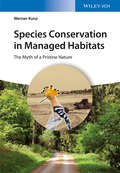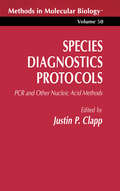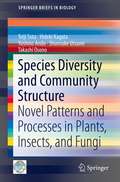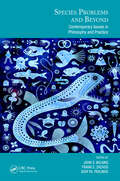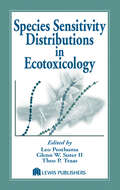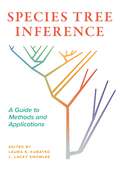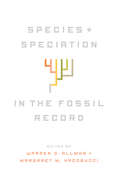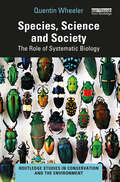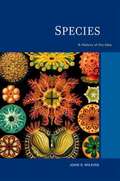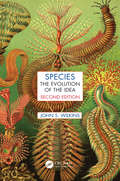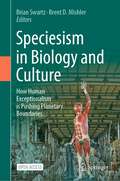- Table View
- List View
Special Topics in Quantum Optics
by Weiping Zhang Zeng-Bing ChenThis book highlights quantum optics technologies that can revolutionize the way we encode, store, transmit, and handle information. These technologies can help us overcome bottlenecks in classical physics-based information technology in information transmission capacity, computing speed, and information security. The book provides readers with new perspectives on potential applications of the quantum theory. Besides, the book summaries the research advances in quantum optics and atom optics, including manipulation and construction of the quantum states of photons and even atoms, molecules, and matter at the quantum level, and new phenomena and technologies brought about by the interactions between photons and the quantum states of matter. The book provides extensive and thoroughly exhaustive coverage of quantum optics. It is suitable for researchers and graduate students of optical physics and quantum optics.
Special Topics in Structural Dynamics & Experimental Techniques, Vol. 5: A Conference and Exposition on Structural Dynamics 2024 (Conference Proceedings of the Society for Experimental Mechanics Series)
by Dario Di MaioSpecial Topics in Structural Dynamics & Experimental Techniques, Volume 5: Proceedings of the 42nd IMAC, A Conference and Exposition on Structural Dynamics, 2024, the fifth volume of ten from the Conference brings together contributions to this important area of research and engineering. The collection presents early findings and case studies on fundamental and applied aspects of Structural Dynamics, including papers on: Active Control Experimental Techniques Finite Element Techniques Multifunction Structures System Identification Additive Manufacturing Rotating Machinery
Special Topics in Structural Dynamics & Experimental Techniques, Volume 5: Proceedings of the 37th IMAC, A Conference and Exposition on Structural Dynamics 2019 (Conference Proceedings of the Society for Experimental Mechanics Series)
by Nikolaos DervilisSpecial Topics in Structural Dynamics & Experimental Techniques, Volume 5: Proceedings of the 37th IMAC, A Conference and Exposition on Structural Dynamics, 2019, the fifth volume of eight from the Conference brings together contributions to this important area of research and engineering. The collection presents early findings and case studies on fundamental and applied aspects of Structural Dynamics, including papers on:Analytical MethodsEmerging Technologies for Structural DynamicsEngineering ExtremesExperimental TechniquesFinite Element TechniquesGeneral Topics
Special Topics in Structural Dynamics, Volume 5: Proceedings Of The 36th Imac, A Conference And Exposition On Structural Dynamics 2018 (Conference Proceedings of the Society for Experimental Mechanics Series)
by Nikolaos DervilisSpecial Topics in Structural Dynamics, Volume 5: Proceedings of the 36th IMAC, A Conference and Exposition on Structural Dynamics, 2018, the fifth volume of nine from the Conference brings together contributions to this important area of research and engineering. The collection presents early findings and case studies on fundamental and applied aspects of Structural Dynamics, including papers on:Experimental MethodsAnalytical MethodsGeneral Dynamics & Modal AnalysisGeneral Dynamics & System IdentificationDamage Detection
Special Topics in Structural Dynamics, Volume 6: Proceedings of the 31st IMAC, A Conference on Structural Dynamics, 2013
by Alfred Wicks Christopher Niezrecki Randall Allemang James De ClerckSpecial Topics in Structural Dynamics, Volume 6: Proceedings of the 31st IMAC, A Conference and Exposition on Structural Dynamics, 2013, the sixth volume of seven from the Conference, brings together contributions to this important area of research and engineering. The collection presents early findings and case studies on fundamental and applied aspects of Structural Dynamics, including papers on: Teaching Experimental & Analytical Structural Dynamics Sensors & Instrumentation Aircraft/Aerospace Bio-Dynamics Sports Equipment Dynamics Advanced ODS & Stress Estimation Shock & Vibration Full-Field Optical Measurements & Image Analysis Structural Health Monitoring Operational Modal Analysis Wind Turbine Dynamics Rotating Machinery Finite Element Methods Energy Harvesting
Special Topics on Materials Science and Technology - The Italian Panorama
by D. Caputo D. Acierno A. D’Amore R. CioffiThis volume collects selected papers presented and discussed during the 9th National Conference organized by the Italian Association of Materials Engineering, AIMAT from 2008 at Piano di Sorrento (Napoli, Italy). It gives a valuable representation of highlights of the research and development activities running in 21 Italian universities and resear
Specialization, Speciation, and Radiation: The Evolutionary Biology of Herbivorous Insects
by Kelley Jean TilmonThis pioneering volume is a comprehensive, up-to-date treatment of the evolutionary biology of herbivorous insects, including their relationships with host plants and natural enemies. Chapters focus on the dynamic relationships between insects and plants from the standpoint of evolutionary change at different levels of biological organization--individuals, populations, species, and clades.
Specialty Construction Techniques for Dam and Levee Remediation
by Donald A. BruceDam and levee remediation has become more prevalent since the start of the twenty-first century. Given the vastness and complexity of the infrastructures involved, keeping up with maintenance needs is very difficult. Major surges in repair are usually triggered by nature‘s wake-up calls, such as hurricanes, floods, and earthquakes. The challenge ha
Specialty Corns
by Arnel R. HallauerCompletely revised and updated, the Second Edition of Specialty Corns includes everything in the first edition and more. Considered the standard in this field, significant changes have been made to keep all the information current and bring the references up-to-date. Two new chapters have been added to keep up with the latest trends: Blue Corn and
Specialty Polymers: Fundamentals, Properties, Applications and Advances
by Ram K. GuptaThis comprehensive volume provides current, state-of-the-art information on specialty polymers that can be used for many advanced applications. The book covers the fundamentals of specialty polymers, synthetic approaches, and chemistries to modify their properties to meet the requirements for special applications, along with current challenges and prospects. Chapters are written by global experts, making this a suitable textbook for students and a one-stop resource for researchers and industry professionals. Key Features: - Presents synthesis, characterization, and applications of specialty polymers for advanced applications. - Provides fundamentals and requirements for polymers to be used in many advanced and emerging areas. - Details novel methods and advanced technologies used in polymer industries. - Covers the state-of-the-art progress on specialty polymers for a range of advanced applications.
Species Concepts and Phylogenetic Theory: A Debate
by Rudolf Meier Quentin WheelerNo question in theoretical biology has been more perennially controversial or perplexing than "What is a species?" Recent advances in phylogenetic theory have called into question traditional views of species and spawned many concepts that are currently competing for general acceptance. Once the subject of esoteric intellectual exercises, the "species problem" has emerged as a critically important aspect of global environmental concerns. Completion of an inventory of biodiversity, success in conservation, predictive knowledge about life on earth, management of material resources, formulation of scientifically credible public policy and law, and more depend upon our adoption of the "right" species concept.Quentin D. Wheeler and Rudolf Meier present a debate among top systematic biology theorists to consider the strengths and weaknesses of five competing concepts. Debaters include (1) Ernst Mayr (Biological Species Concept), (2) Rudolf Meier and Rainer Willmann (Hennigian species concept), (3) Brent Mishler and Edward Theriot (one version of the Phylogenetic Species Concept), (4) Quentin Wheeler and Norman Platnick (a competing version of the Phylogenetic Species Concept), and (5) E. O. Wiley and Richard Mayden (the Evolutionary Species Concept).Each author or pair of authors contributes three essays to the debate: first, a position paper with an opening argument for their respective concept of species; second, a counterpoint view of the weakness of competing concepts; and, finally, a rebuttal of the attacks made by other authors. This unique and lively debate format makes the comparative advantages and disadvantages of competing species concepts clear and accessible in a single book for the first time, bringing to light numerous controversies in phylogenetic theory, taxonomy, and philosophy of science that are important to a wide audience. Species Concepts and Phylogenetic Theory will meet a need among scientists, conservationists, policy-makers, and students of biology for an explicit, critical evaluation of a large and complex literature on species. An important reference for professionals, the book will prove especially useful in classrooms and discussion groups where students may find a concise, lucid entrée to one of the most complex questions facing science and society.
Species Concepts in Biology
by Frank E. ZachosFrank E. Zachos offers a comprehensive review of one of today's most important and contentious issues in biology: the species problem. After setting the stage with key background information on the topic, the book provides a brief history of species concepts from antiquity to the Modern Synthesis, followed by a discussion of the ontological status of species with a focus on the individuality thesis and potential means of reconciling it with other philosophical approaches. More than 30 different species concepts found in the literature are presented in an annotated list, and the most important ones, including the Biological, Genetic, Evolutionary and different versions of the Phylogenetic Species Concept, are discussed in more detail. Specific questions addressed include the problem of asexual and prokaryotic species, intraspecific categories like subspecies and Evolutionarily Significant Units, and a potential solution to the species problem based on a hierarchical approach that distinguishes between ontological and operational species concepts. A full chapter is dedicated to the challenge of delimiting species by means of a discrete taxonomy in a continuous world of inherently fuzzy boundaries. Further, the book outlines the practical ramifications for ecology and evolutionary biology of how we define the species category, highlighting the danger of an apples and oranges problem if what we subsume under the same name ("species") is in actuality a variety of different entities. A succinct summary chapter, glossary and annotated list of references round out the coverage, making the book essential reading for all biologists looking for an accessible introduction to the historical, philosophical and practical dimensions of the species problem.
Species Conservation in Managed Habitats: The Myth of a Pristine Nature
by Werner KunzWritten by an author with longstanding experience in the ecology of insects and birds and with a stellar academic record in molecular life sciences, this is a welcome challenge to the widely held beliefs in conventional environmental policies. Werner Kunz convincingly explains why maintaining high biodiversity in Europe depends heavily on the existence of open space and sparse ground vegetation that is neither used for intensive modern agriculture, nor eliminated by reforestation. He questions the commonly propagated opinion that nature conservation is equivalent to species protection - and shows that technical habitat design can rescue endangered species. A must-have for environmental agencies, policy makers, ecologists and all who are witnessing the current loss of species in Central Europe.
Species Diagnostics Protocols
by Justin P. ClappIn Species Diagnostics Protocols leading practitioners describe in full detail numerous methods for identifying many organisms by means of nucleic acid analysis. The applications range from medical diagnosis and plant pathology to medical entomology, mycology, and molecular ecology. The organisms identified include plant, insect, and vertebrate DNA; viruses (phytopathogenic, HIV, human papilloma, dengue); bacteria; fungi; protozoans; parasites; and mosquitoes. The detailed techniques can easily be modified for use with many other and novel species. Species Diagnostics Protocols is the only book available dealing solely with the identification of species using molecular techniques. Its detailed, step-by-step instructions and extensive notes on pitfalls ensure success even for those with little prior experience.
Species Diversity and Community Structure: Novel Patterns and Processes in Plants, Insects, and Fungi
by Teiji Sota Yoshino Ando Takashi Osono Hideki Kagata Shunsuke UtsumiThis book introduces recent progress in the study of species diversity and community structures in terrestrial organisms conducted by three groups at Kyoto University. First, it explains species diversity and the functioning of fungi in Asian regions as outlined by metagenomic approaches using next-generation sequencing technology. The advances in high-throughput sequencing technologies accelerate the speed of species inventorying, especially for microorganisms. Second, the study of complex interactions between herbivorous insects and plants in the community and ecosystem contexts is presented. Recent studies in community and ecosystem genetics shed light on these complex interactions with novel approaches incorporating genetic perspectives including genetic variation and phenotypic plasticity in plant defenses against herbivores. Finally, recent studies on speciation processes in insects are described, processes that are related to the evolution of particular life history strategies. Included is an examination of two hypotheses that may be important in understanding diversification of insect species in heterogeneous environments in space and time. This book is a valuable resource especially for ecologists who are interested in species diversity and community structure.
Species Diversity of Animals in Japan
by Masaharu Motokawa Hiroshi KajiharaThis book summarizes the status quo of the knowledge about the biodiversity in terrestrial, freshwater, and marine animals that live in Japan. Consisting of some 6,800 islands that are arrayed for approximately 3,500 km from north to south, the Japanese archipelago has a complex history in a paleogeographic formation process over time and harbors rich flora and fauna. This work will contribute to establishing a general biogeographic theory in archipelagoes around continental shelves. Facing the ongoing extinction crisis, one of the most important tasks for our generation is to bequeath this precious natural heritage to future generations. As the first step toward this goal, a species list has been compiled through solid, steady alpha-taxonomic work in each taxon. Furthermore, the phylogeography and population genetic structure for each species is elucidated for deeper understanding of the local fauna, the scientific results of which should be the basis for establishing conservation policies and strategies. Also the problem of alien or introduced species is investigated as another threat to the native fauna. Each of the 27 chapters is written by the most active specialist leading the field, thus readers can acquire up-to-date knowledge of the animal species diversity and their formation process of Japanese animals in the most comprehensive form available. This book is recommended for researchers and students who are interested in species diversity, biogeography, and phylogeography.
Species Problems and Beyond: Contemporary Issues in Philosophy and Practice (Species and Systematics)
by John S. Wilkins, Frank E. Zachos, and Igor Ya. PavlinovSpecies Problems and Beyond offers a collection of up-to-date essays discussing from an interdisciplinary perspective the many ramifications of the ‘Species Problem.’ The authors represent experts in the philosophy of biology, in species-level evolutionary investigations, and in biodiversity studies and conservation. Some of the topics addressed concern the context sensitivity of the term ‘species’; species as individuals, processes, natural kinds, or as ‘operative concepts’; species delimitation in the age of Big (genomic) Data; and taxonomic inflation and its consequences for conservation strategies. The carefully edited volume will be an invaluable resource for philosophers of biology and evolutionary biologists alike. – Olivier Rieppel, Rowe Family Curator of Evolutionary Biology, Negaunee Integrative Research Center, Field Museum, USASpecies, or ‘the Species Problem’, is a topic in science, in the philosophy of science, and in general philosophy. In fact, it encompasses many aspects of the same problem, and these are dealt with in this volume. Species are often thought of as fundamental units of biological matter to be used in ecology, conservation, classification, and biodiversity. The chapters in this book present opposing views on the current philosophical and conceptual issues of the Species Problem in biology.Divided into four sections, Concepts and Theories, Practice and Methods, Ranks and Trees and Names, and Metaphysics and Epistemologies, the book is authored by biologists, philosophers, and historians, many leaders in their fields. Topics include ontology of species, definitions of both species category and units, species rank, speciation issues, nomenclature, ecology, and species conservation.Species Problems and Beyond aims to clarify the contemporary issues of the Species Problem. It is ideal for use in upper-level seminars and courses in Evolutionary Biology, Philosophy of Science, Philosophy of Biology, Systematics and Taxonomy, and Phylogenetics/Cladistics, and for any scholar in these fields.
Species Sensitivity Distributions in Ecotoxicology
by Glenn W. Suter II Leo Posthuma Theo P. TraasIn spite of the growing importance of Species Sensitivity Distribution models (SSDs) in ecological risk assessments, the conceptual basis, strengths, and weaknesses of using them have not been comprehensively reviewed. This book fills that need. Written by a panel of international experts, Species Sensitivity Distributions in Ecotoxicology reviews
Species Tree Inference: A Guide to Methods and Applications
by Stephen A. Smith Kyle A. Gallivan Luay Nakhleh Tandy Warnow Stacey D. Smith Paul D. Blischak Jeremy M. Brown Zhen Cao Alison Cloutier Kerry Cobb Alexandria A. DiGiacomo Deren A. Eaton Scott V. Edwards Daniel J. Gates Phil Grayson Xinhao Liu Patrick F. McKenzie Siavash Mirarab Erin Molloy Genevieve G. Mount Jamie R. Oaks Huw A. Ogilvie James B. Pease Diana Pilson Timothy B. Sackton Claudia Solís-Lemus David L. Swofford Coleen E. Thompson Emiko M. Waight Joseph F. Walker Ellen I. Weinheimer James C. Wilgenbusch Andrea D. Wolfe Zhi YanAn up-to-date reference book on phylogenetic methods and applications for evolutionary biologistsThe increasingly widespread availability of genomic data is transforming how biologists estimate evolutionary relationships among organisms and broadening the range of questions that researchers can test in a phylogenetic framework. Species Tree Inference brings together many of today’s leading scholars in the field to provide an incisive guide to the latest practices for analyzing multilocus sequence data.This wide-ranging and authoritative book gives detailed explanations of emerging new approaches and assesses their strengths and challenges, offering an invaluable context for gauging which procedure to apply given the types of genomic data and processes that contribute to differences in the patterns of inheritance across loci. It demonstrates how to apply these approaches using empirical studies that span a range of taxa, timeframes of diversification, and processes that cause the evolutionary history of genes across genomes to differ.By fully embracing this genomic heterogeneity, Species Tree Inference illustrates how to address questions beyond the goal of estimating phylogenetic relationships of organisms, enabling students and researchers to pursue their own research in statistically sophisticated ways while charting new directions of scientific discovery.
Species and Speciation in the Fossil Record
by Margaret M. Yacobucci Warren D. Allmon and Margaret M. YacobucciAlthough the species is one of the fundamental units of biological classification, there is remarkably little consensus among biologists about what defines a species, even within distinct sub-disciplines. The literature of paleobiology, in particular, is littered with qualifiers and cautions about applying the term to the fossil record or equating such species with those recognized among living organisms. In Species and Speciation in the Fossil Record, experts in the field examine how they conceive of species of fossil animals and consider the implications these different approaches have for thinking about species in the context of macroevolution. After outlining views of the Modern Synthesis of evolutionary disciplines and detailing the development within paleobiology of quantitative methods for documenting and analyzing variation within fossil assemblages, contributors explore the challenges of recognizing and defining species from fossil specimens—and offer potential solutions. Addressing both the tempo and mode of speciation over time, they show how with careful interpretation and a clear species concept, fossil species may be sufficiently robust for meaningful paleobiological analyses. Indeed, they demonstrate that the species concept, if more refined, could unearth a wealth of information about the interplay between species origins and extinctions, between local and global climate change, and greatly deepen our understanding of the evolution of life.
Species, Science and Society: The Role of Systematic Biology (Routledge Studies in Conservation and the Environment)
by Quentin WheelerThis book presents an engaging and accessible examination of the role of systematic biology in species exploration and biodiversity conservation. Our planet and systematic biology are at a crossroads. Millions of species face an imminent threat of extinction, and, with knowledge of only a fraction of earth’s species we are unprepared to respond. Species, Science and Society explains what is at stake if we continue to ignore the traditional mission of systematics. Rejecting claims that it is too late to document earth’s species, that molecular evidence is sufficient and that comparative morphology and the grand traditions of systematics are outdated, this book makes a compelling argument for a taxonomic renaissance. The book challenges readers to rethink assumptions about systematics. Shattering myths and misconceptions and clarifying the role of systematics in confronting mass extinction, it hopes to inspire a new generation of systematists. Readers are given a deeply personal view of the mission, motivations and rewards of systematic biology. Written in narrative style with passion, wit and optimism, it is the first book to question the growing dominance of molecular data, defend descriptive taxonomy and propose a mission to discover, describe and classify all species. Our evolutionary heritage, the fate of society and the future of the planet depend on what we do next. This book will be of great interest to academics, researchers and professionals working in systematics, taxonomy and biodiversity conservation, as well as students with a basic background in biology.
Species, Science and Society: The Role of Systematic Biology (Routledge Studies in Conservation and the Environment)
by Quentin Wheeler- presents an engaging and accessible examination of the role of systematic biology in species exploration and biodiversity conservation - clarifies misconceptions about systematic biology, reimagining it for the 21st Century - proposes an ambitious, planetary-scale project to inventory and make known every kind of plant, animal, and microbe on Earth - challenges the next and present generations of taxonomists to allow molecular data to assume it’s proper place alongside traditional data, to reembrace the fundamentally important mission of systematics - will be of great interest to those researching and working in systematics in botany and zoology, as well as professionals working in taxonomy and biodiversity conservation.
Species: A History of the Idea
by John S. WilkinsThe complex idea of "species" has evolved over time, yet its meaning is far from resolved. This lucidly written, comprehensive work takes a fresh look at an idea central to the field of biology by tracing its history from antiquity to today.
Species: The Evolution of the Idea, Second Edition (Species and Systematics)
by John S. WilkinsOver time the complex idea of "species" has evolved, yet its meaning is far from resolved. This comprehensive work is a fresh look at an idea central to the field of biology by tracing its history from antiquity to today. Species is a benchmark exploration and clarification of a concept fundamental to the past, present, and future of the natural sciences. In this edition, a section is added on the debate over species since the time of the New Synthesis, and brings the book up to date. A section on recent philosophical debates over species has also been added. This edition is better suited non-specialists in philosophy, so that it will be of greater use for scientists wishing to understand how the notion came to be that living organisms form species. Key Selling Features: Covers the philosophical and historical development of the concept of "species" Documents that variation was recognized by pre-Darwinian scholars Includes a section on the debates since the time of the New Synthesis Better suited to non-philosophers
Speciesism in Biology and Culture: How Human Exceptionalism is Pushing Planetary Boundaries
by Brent D. Mishler Brian SwartzThis open access book explores a wide-ranging discussion about the sociopolitical, cultural, and scientific ramifications of speciesism and world views that derive from it. In this light, it integrates subjects across the natural sciences, social sciences, and humanities. The 21st-century western world is anthropocentric to an extreme; we adopt unreasonably self-centered and self-serving ideas and lifestyles. Americans consume more energy resources per person than most other nations on Earth and have little concept of how human ecology and population biology interface with global sustainability. We draw upon religion, popular culture, politics, and technology to justify our views and actions, yet remain self-centered because our considerations rarely extend beyond our immediate interests. Stepping upward on the hierarchy from “racism,” “speciesism” likewise refers to the view that unique natural kinds (species) exist and are an important structural element of biodiversity. This ideology manifests in the cultural idea that humans are distinct from and intrinsically superior to other forms of life. It further carries a plurality of implications for how we perceive ourselves in relation to nature, how we view Judeo-Christian religions and their tenets, how we respond to scientific data about social problems such as climate change, and how willing we are to change our actions in the face of evidence.
